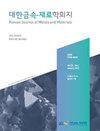Effect of Supersonic Oxygen Lance on Post-Combustion in Converter Steelmaking Process – Experiment and Analysis with Converter Simulator
IF 1.1
4区 材料科学
Q4 MATERIALS SCIENCE, MULTIDISCIPLINARY
引用次数: 0
Abstract
Employing post-combustion technology in the converter, using the sensible heat of the hot metal and the oxidation reaction heat as a heat source, is known to compensate for insufficient heat in the converter process. However, most studies on post-combustion have been conducted using subsonic nozzles, whereas actual converter processes use supersonic nozzles. Therefore, research on the combustion behavior of supersonic jets is needed. In this study, experiments and analyses were conducted using a converter simulator and a supersonic nozzle to investigate the effect of nozzle height on the post-combustion behavior. The reaction was set to complete combustion, with an O2gas flow rate of 150 L/min blown through the upper lance and a CO gas flow rate of 300 L/min blown at the bottom of the simulator to represent the surface of the molten metal. The combustion reaction of CO gas was calculated to be rate-controlled by reactant mixing. The nozzle heights were set to 250, 380, and 530 mm from the surface of the molten metal. Post-combustion analysis showed that the lowest gas velocity was observed under the condition of the highest nozzle height of 530 mm, and the high temperature and reaction zones were widely distributed in the lower region. Therefore, to facilitate heat compensation to the molten metal, it is necessary to control the gas velocity of the molten steelgas interface slowly.超声速氧枪对转炉炼钢后燃烧的影响——转炉模拟器实验与分析
已知在转炉中采用后燃烧技术,使用热金属的显热和氧化反应热作为热源,以补偿转炉过程中的热量不足。然而,大多数关于后燃烧的研究都是使用亚音速喷嘴进行的,而实际的转炉工艺使用超音速喷嘴。因此,有必要对超音速射流的燃烧行为进行研究。在本研究中,使用转换器模拟器和超音速喷嘴进行了实验和分析,以研究喷嘴高度对后燃烧行为的影响。将反应设定为完全燃烧,通过上部喷枪吹送的O2气体流速为150L/min,在模拟器底部吹送的CO气体流速为300L/min,以表示熔融金属的表面。CO气体的燃烧反应被计算为通过反应物混合来控制速率。喷嘴高度设置为距熔融金属表面250、380和530mm。燃烧后分析表明,在最高喷嘴高度为530mm的条件下,气体速度最低,高温区和反应区广泛分布在下部区域。因此,为了便于对熔融金属进行热补偿,有必要缓慢控制钢水-气体界面的气体速度。
本文章由计算机程序翻译,如有差异,请以英文原文为准。
求助全文
约1分钟内获得全文
求助全文
来源期刊

Korean Journal of Metals and Materials
MATERIALS SCIENCE, MULTIDISCIPLINARY-METALLURGY & METALLURGICAL ENGINEERING
CiteScore
1.80
自引率
58.30%
发文量
100
审稿时长
4-8 weeks
期刊介绍:
The Korean Journal of Metals and Materials is a representative Korean-language journal of the Korean Institute of Metals and Materials (KIM); it publishes domestic and foreign academic papers related to metals and materials, in abroad range of fields from metals and materials to nano-materials, biomaterials, functional materials, energy materials, and new materials, and its official ISO designation is Korean J. Met. Mater.
 求助内容:
求助内容: 应助结果提醒方式:
应助结果提醒方式:


